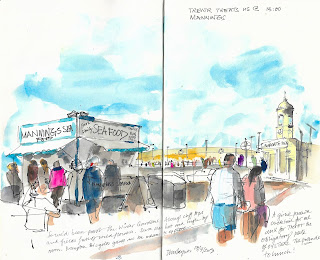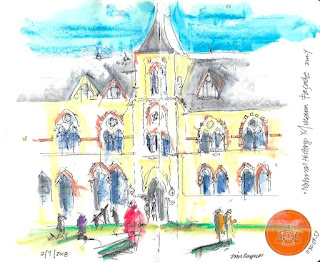We soon passed DreamlandAmusement Park ‘with Cinema, Ballroom, Restaurant, Licenced café and bars’. Further along Marine Terrace becomes Marine Drive. In the sun the whole place takes on the feel of Venice Beach CA. A feeling amplified by a strong blue sky, and against this is the sharp white shape of the Turner Contemporary building.
With our Brompton Bikes so distance was no object. We were soon upon the elegant Clock Tower, Buoy and Oyster Caféand onwards-past Peter Fish Factoryto which returned later (Haddock and Chips £3.75).
Some of Margate is dishevelled and desolate. Once honoured pagodas and shelters, spaces that once offered refuge from rain wind or sun are now falling apart. Although in one of these shelters, on Nayland Rock promenade, TS Eliot had sat while writing Part III of The Waste Land. So it now enjoys listed status from English Heritage.
It is an easy two-mile peddle from the Harbour Arm across the headland to the Water Waste Pumping Station. This is itself an architectural fancy, set against a cobalt noon sky and clear turquoise sea.
We passed the Winter Gardens; Abba’s music drifted up to greet us. I discovered later an Abba Tribute Band was appearing soon.
Back in the town centre Trevor proposed a stop at Manning’s Sea Food Stand.
He enjoyed his usual half-dozen oysters and I feasted on a prawn cocktail.
Margate is so thoughtful vis-à-vis the day-tripper. If you do not want to get sand between your toes there is a shallow concrete amphitheatre of steps to walk you down to the water’s edge. It was here we enjoyed our haddock and chips to which Trevor thoughtful asked Peter’s Fish Factory to add a very large gherkin to each portion.
The sun was now high and I removed my sandals and went for a paddle, my first in this series of ten jaunts to explore our curious coast.
TRAVELS WITH MY ARCHITECT
The offbeat, kiss-me-quick atmosphere of the East Anglian and Kent seaside and coast fascinates architect and photographer Trevor Clapp and I.
These places portrayed in photographs and drawings we have taken/made at the time of each visit and the words I write soon after under the banner of Travels with my Architect. His implacable architectural eye has created some great photo’s, which will soon find a home on a dedicated website.
Some of the jaunts and drawings have been published and a book is available called Curious Coast.
























